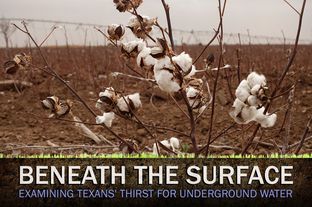Texans Look
Beneath the Surface for Water
By Neena
Satija November 19, 2013
This is the first in a
five-part series examining Texans' thirst for underground water.
From farmers to the oil and gas industry to gubernatorial candidate and
Attorney General Greg Abbott, Texans are looking beneath their
land to make up the state’s growing water deficit.
Unlike surface water, which is owned
and allocated by the state, groundwater belongs to the landowner and is
regulated by nearly 100 different conservation districts across Texas, all of
which set their own rules. The recent drought, along with major court decisions, has led to what some say
is the most uncertain time in state history for those who depend on and manage
groundwater in Texas.
Property rights advocates have
lauded recent court rulings affirming Texans’ ownership of water under their
land after some water districts attempted to limit pumping in hopes of
conserving precious remaining groundwater. But managers of water conservation
districts fear that if courts continue to restrict their ability to regulate
groundwater use, there may soon be no water left to pump.
“You just kind of have to wonder
what’s behind the next door,” said Jason Coleman, general manager of the
Lubbock-based High Plains Underground Water District, the oldest groundwater
regulatory agency in the state.
Coleman’s job is fraught with
political tension. He manages the water district that lies over the Ogallala Aquifer. It's one of the largest
groundwater resources in the country, stretching across eight Western states,
supplying drinking water for millions and supporting an estimated 25 percent of
the nation's agricultural production.
In the past 60 years, according to
the U.S. Geological Survey, the aquifer has been pumped so heavily that water
that has built up over 10,000 years is quickly depleting. Unlike most aquifers
in Texas, the Ogallala gets very little water from “recharge” — the
process by which rain percolates through the ground and replaces lost
groundwater.
Yet when
the High Plains district suggested setting pumping limits on the Ogallala for
the first time in 2011, the board faced a public outcry. Farmers attended meetings in
droves, calling district leaders “socialists” and “tyrannical.” Under the new
rules, pumping would be limited to about 570,000 gallons per acre per year
in 2012, and restrictions would get more severe in the following
years. The district’s board quickly backed down, saying no one would be
penalized for violating the rules for at least a year.Read More

No comments:
Post a Comment